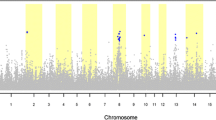Abstract
The INSL3 gene encoding Leydig cell insulin-like hormone is an important candidate gene for congenital disorders of the reproductive tract in pigs. Comparative sequencing using phenotypically hernia inguinalis affected and unaffected animals showed that the porcine gene is remarkably conserved. No polymorphisms were found in the two exons or in the intron. Two single-nucleotide polymorphisms (SNPs) were detected in the promoter region (G-224A and A-164C) of the sequenced pigs and fast screening methods were developed for large scale studies. Some significant breed differences exist for allele frequencies at both SNPs in the INSL3 gene. Screening of the two SNPs in a population of hernia inguinalis affected full and half sib piglets (n = 223) revealed that the SNPs can be excluded as a common genetic basis for this congenital disorder in this pedigree.
Similar content being viewed by others
REFERENCES
Baker, L. A., Nef, S., Nguyen Ronita Stapleton, M. T., Pohl, H., and Parada, L. F. (2002). The insulin-3 gene: Lack of a genetic basis for human cryptorchidism. J. Urol. 167:2534.
Burkhardt, E., Adham, I. M., Brosig, B., Gastmann, A., Mattai, M.-G., and Engel, W. (1994). Structural organization of the porcine and human genes coding for a Leydig cell-specific insulin-like peptide (LEY I-L) and chromosomal localization of the human gene (INSL3). Genomics 20:13.
Gong, Y., Petersen, A. H., and Bendixen, C. (2002). Seven SNPs in the porcine INSL3gene encoding Leydig cell insulin like hormone. Anim. Genet. 33:160.
Gudbjartsson, D. F., Jonasson, K., Frigge, M., and Kong, A. (2000). ALLEGRO, a new computer program for multipoint linkage analysis. Nat. Genet. 25:12.
Lander, E., and Kruglyak, L. (1995). Genetic dissection of complex traits: Guidelines for interpreting and reporting linkage results. Nat. Genet. 11:241.
Nef, S., and Parada, L. F. (1999). Cryptorchidism in mice mutant for INSL3. Nat. Genet. 22:295.
Quandt, K., Frech, K., Karas, H., Wingender, E., and Werner, T. (1995). MatInd and MatInspector: new fast and versatile tools for detection of consensus matches in nucleotide sequence data. Nucleic Acids Res. 23:4878.
Rettenberger, G., Burkhardt, E., Adham, I. M., Engel, W., Fries, R., Klett, C., and Hameister, H. (1994).Assignment of the Leydig insulin-like hormone to porcine chromosome 2q12→q13 by somatic cell hybrid analysis and fluorescence in situ hybridization. Mamm. Genome 5:307.
Rothschild, M. F., Christian, L. L., and Blanchard, L. W. (1988). Evidence for multigene control of cryptorchidism in swine. J. Hered. 79:313.
SAS Institute Inc. (1999-2001). SAS/STAT Guide: SAS Institute Inc., Cary, North Carolina, USA.
Tomboc, M., Lee, P. A., Mitwally, M. F., Schneck, F. X., Bellinger, M., and Witchel, S. F. (2000). Insulinlike 3/relaxin factor gene mutations are associated with cryptorchidism. J. Clin. Endocrinol. Metab. 85:4013.
Wrathall, A. E. (1988). The boar and congential problems. Pig Vet. Soc. Proc. 21:117.
Zimmermann, S., Steding, G., Emmen, J. M. A., Brinkmann, A. O., Nayernia, K., Holstein, A. F., Engel, W., and Adham, I. M. (1999). Targeted disruption of the INSL3gene causes bilateral cryptorchidism. Mol. Endocrinol. 13:681.
Author information
Authors and Affiliations
Rights and permissions
About this article
Cite this article
Knorr, C., Täubert, H., Peters, U. et al. Characterization of Two SNPs (Single Nucleotide Polymorphisms) in the Porcine INSL3 Gene and Their Exclusion as a Common Genetic Basis of Hernia Inguinalis in Pigs. Biochem Genet 42, 11–19 (2004). https://doi.org/10.1023/B:BIGI.0000012140.41292.a9
Issue Date:
DOI: https://doi.org/10.1023/B:BIGI.0000012140.41292.a9




